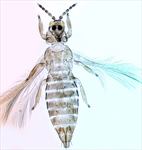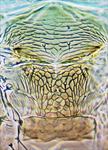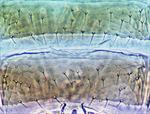
Female

Head

Antenna

Pronotum

Mesonotum and metanotum

Abdominal tergites VI–IX

Abdominal sternites VI–VII

Fore wing
Both sexes fully winged. Body and legs yellow with faint shadings, distal antennal segments darkest, wings pale. Antennae 8-segmented, III & IV each with a small forked sense cone. Head and pronotum with no prominent setae. Head with 3 pairs of minute ocellar setae, pair III on anterior margins of triangle; 2 pairs of minute postocellar setae. Metanotum reticulate, median setae small and far back from anterior margin. Fore wing first vein with 4 or 5 widely spaced small setae on distal half, second vein with 8 to 10 small setae; marginal cilia not wavy. Abdominal tergites II–VII with posteromarginal craspedum that is toothed laterally, median setae longer than the distance between their bases; tergite VIII with posteromarginal comb of fine microtrichia; IX with median setae shorter than submedian pair. Sternites IV–VI with about 8 small marginal setae, also 8–10 small discal setae.
Male sternite III with glandular opening medially on antecostal region.
Only two species are recognized in this genus. The second one, B. limbatus (Hood), is known from various parts of the Caribbean area in association with the weed Chamaesyce hyssopifolia [Euphorbiaceae] (Mound & Marullo, 1996).
Presumably flower-living, and possibly associated with a species of Euphorbia [Euphorbiaceae].
Recorded from California, Arizona, New Mexico and Texas.
THRIPIDAE - THRIPINAE
Baileyothrips arizonensis (Morgan)
Anaphothrips arizonensis Morgan, 1913: 12
Anaphothrips minutus Moulton, 1929: 127
Mound LA & Marullo R (1996) The Thrips of Central and South America: An Introduction. Memoirs on Entomology, International 6: 1–488.